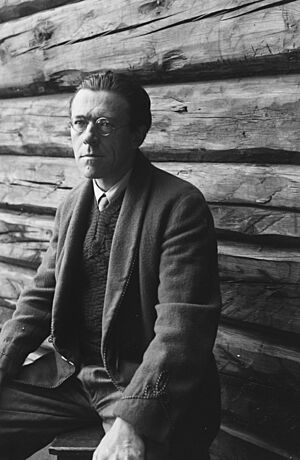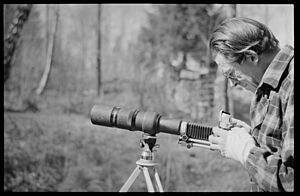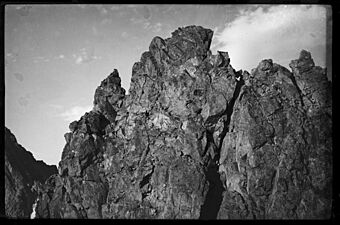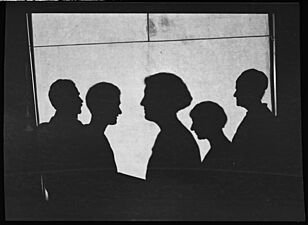Peter Wessel Zapffe facts for kids
Quick facts for kids
Peter Wessel Zapffe
|
|
|---|---|

Zapffe in 1949
|
|
| Born | 18 December 1899 Tromsø, Norway
|
| Died | 12 October 1990 (aged 90) Asker, Norway
|
| Alma mater | University of Oslo |
|
Notable work
|
|
| Spouse(s) |
Bergliot Espolin Johnson
(m. 1935; div. 1941)Berit Riis Christensen
(m. 1952) |
| Awards | Fritt Ord Honorary Award (1987) |
| Era | 20th-century philosophy |
| School |
|
|
Main interests
|
Metaphysics, nihilism, philosophical pessimism |
|
Notable ideas
|
|
|
Influences
|
|
|
Influenced
|
|
Peter Wessel Zapffe (born December 18, 1899 – died October 12, 1990) was a talented Norwegian thinker. He was many things: a philosopher, writer, artist, lawyer, and even a mountaineer. Zapffe is known for his unique and sometimes challenging ideas about human existence. He believed that life can be difficult for humans. His philosophy was influenced by the German philosopher Arthur Schopenhauer. Zapffe also strongly supported antinatalism, which is the idea that it might be better not to have children. His main ideas are found in his essay "The Last Messiah" (written in 1933) and his longer book On the Tragic (published in 1941).
Contents
Peter Wessel Zapffe's Ideas
Zapffe thought that humans have a special ability to understand and know themselves. This ability, he believed, is much stronger than what nature designed us for. He felt that humans constantly search for answers about life and death, but these answers are impossible to find. This creates a problem: humans have needs that nature cannot fulfill. According to Zapffe, this makes human life a kind of paradox, meaning we are constantly trying to avoid being truly human.
How Humans Cope with Life
In his essay "The Last Messiah," Zapffe described four main ways people try to deal with this difficult situation. He called these "defense mechanisms." They are like mental tricks we use to avoid facing uncomfortable truths about life:
- Isolation is when we simply ignore or push away thoughts and feelings that are upsetting. It's like choosing not to think about something that bothers you.
- Anchoring means we create strong beliefs or ideals to focus on. These beliefs give us a sense of purpose and stability. Zapffe said that things like "God, the Church, the State, morality, and even the future" can act as anchors for groups of people.
- Distraction is when we keep ourselves busy with activities or ideas. This stops our minds from thinking too deeply about difficult questions. It's like focusing all your energy on a game or a hobby so you don't worry about other things.
- Sublimation is when we turn negative feelings or thoughts into something positive and creative. For example, writers, poets, or painters might use their art to express their feelings about life. Zapffe himself believed that his own writings were a result of this process.
Adventures and Nature
Zapffe loved the outdoors and was a skilled mountaineer. He was also very interested in environmentalism from an early age. His passion for nature wasn't just about protecting it. He wanted to prevent human culture from changing nature too much. Zapffe also wrote many funny short stories about his climbing trips and other adventures in the wild.
Zapffe's Climbing Achievements
Zapffe started mountaineering in 1921 near Oslo. He was the first person to climb several mountain peaks in Norway. For example, in 1924, he was the first to reach the top of Tommeltott. In 1925, he climbed Småting and Bentsjordtind. He also conquered Okshorn, Snekollen, and Mykkjetind that same year. In 1926, he was the first to climb a summit in Senja and the Hollenderan summit. Later, in 1987, the highest peak of Hollenderan was named "Zapffes tind" (Zapffe's peak) in his honor. He was also the first to climb the front side of Svolværgeita in 1928.
Zapffe applied to a Norwegian mountaineering club in 1940 but was not accepted at first. However, he later became an honorary member of a mountaineering society in 1965 and another club in Tromsø in 1987.
Helping with a Rescue Mission
In 1928, a zeppelin called the Italia, led by Umberto Nobile, crashed on its way back to Italy. Roald Amundsen, a famous explorer and a friend of Zapffe's family, helped with the rescue. Zapffe also joined the rescue mission and acted as an interpreter. Later, he served as a German interpreter on an icebreaker ship that was searching for the missing Amundsen, though they were unsuccessful.
His Life Story
Peter Wessel Zapffe was the son of an apothecary (a type of pharmacist) named Fritz Gottlieb Zapffe and Gudrun Wessel. He was related to the famous Danish-Norwegian admiral Peter Tordenskjold through his mother's side.
Zapffe lived a simple life for many years. In 1978, like the philosopher Emil Cioran, he began living on a state pension. In 1987, he received an award from the Fritt Ord Foundation for his unique and varied writings.
Hobbies and Interests
Zapffe had many hobbies. He enjoyed painting from a young age. Photography became a big interest for him when he was 12, thanks to his father, who was also a photographer. Zapffe's photos often captured his mountain adventures. Many of his photographs are now considered important cultural heritage.
Zapffe was married twice. He first married Bergljot Espolin Johnsen in 1935, and they divorced in 1941. He then married Berit Riis Christensen in 1952, and they stayed together until his death in 1990. Berit passed away in 2008. Zapffe chose not to have children. He was also a lifelong friend of the Norwegian philosopher and fellow mountaineer, Arne Næss.
In his later years, Zapffe was often interviewed. He once described himself as a nihilist. This means he didn't believe in fixed moral rules or that life has an inherent meaning. He said he wasn't a "pessimist" in the sense of being upset, but a "nihilist" because he didn't believe in certain moral truths.
What He Wrote
Here are some of Peter Wessel Zapffe's important works:
- Om det tragiske (On the Tragic), Oslo, 1941.
- Den fortapte sønn. En dramatisk gjenfortælling (The Prodigal Son: A Dramatic Renarration), Oslo, 1951.
- Indføring i litterær dramaturgi (Introduction to Literary Dramaturgy), Oslo, 1961.
- Den logiske sandkasse. Elementær logikk for universitet og selvstudium (The Logical Sandpit: Elementary Logic for University and Individual Study), Oslo, 1965.
- Lyksalig pinsefest. Fire samtaler med Jørgen (Blissful Pentecost: Four Dialogues with Jørgen), Oslo, 1972.
- Hos doktor Wangel. En alvorlig spøk i fem akter (With Doctor Wangel: An Earnest Jest in Five Acts), by Ib Henriksen (pseudonym.), Oslo, 1974. (A play)
- Rikets hemmelighet. En kortfattet Jesus-biografi (The Secret of the Kingdom: A Short Biography of Jesus), Oslo, 1985.
Collections of Shorter Writings
- Essays og epistler (Essays and epistles), Oslo, 1967.
- Barske glæder og andre temaer fra et liv under åpen himmel (Rough Joys, and other themes from a life lived under the open sky), Oslo 1969.
- Spøk og alvor. Epistler og leilighetsvers (Jest and Earnest: epistles and occasional verse), Oslo, 1977.
- Hvordan jeg blev så flink og andre tekster (How I Became So Clever, and other texts), Oslo, 1986.
- Vett og uvett. Stubber fra Troms og Nordland (Sense and Nonsense: Short Stories from Troms and Nordland) by Einar K. Aas and P. W. Zapffe, Trondheim 1942. Illustrated by Kaare Espolin Johnson.
Gallery
See also
- Biosophy
- Emil Cioran
- Existential crisis
- Herman Tønnessen
- Nihilism






